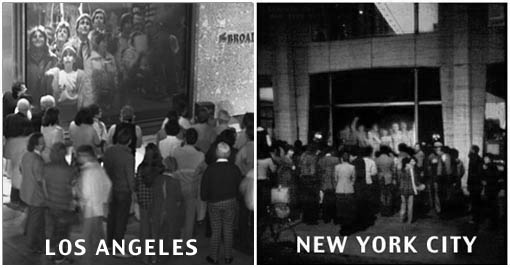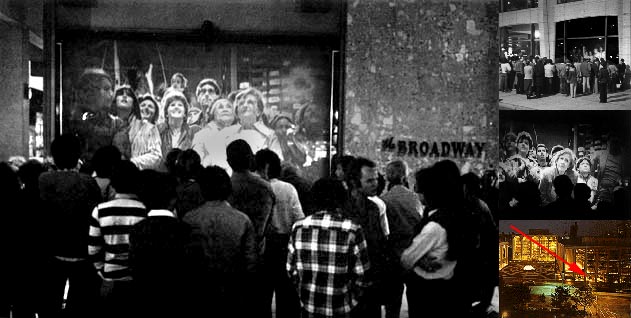Hole in Space
"In 1980, we did Hole in Space, which was an unannounced project, where people in New York and Los Angeles encountered life-sized images of each other on public sidewalks, in public space, out in the open." Kit Galloway, November 2003
Live two-way satellite connection using video screens to project life-size images. Without public announcement, we installed "Hole in Space" in a sidewalk facing window at New York City's Lincoln Center and in a display window at at the Broadway department store in Century City ( Los Angeles). Both screens could accommodate the images of about 15 people. People could converse with people in the other city as if they were standing on the same street corner. "Hole in Space" took place over three evenings. On the first night, people simply discovered it. They used pay-phones of phoned from home to tell friends in the other city to meet them. They all showed up for the second evening, when it also was announced on TV in both locations. On the third night, families from miles away drove into the cities with cars full of kids to meet up with relatives on the other coast whom they hadn't seen in years.
Source: http://www.ecafe.com/museum/cyberart92/Welcome_to_ECI.html
"Hole in Space was a Public Communication Sculpture. On a November evening in 1980 the unsuspecting public walking past the Lincoln Center for the Performing Arts in New York City, and The Broadway department store located in the open air shopping center in Century City, Los Angeles, had a surprising encounter with each other. Suddenly head-to-toe, life-sized, television images of the people on the opposite coast appeared. They could now see, hear, and speak with each other as if encountering each other on the same sidewalk. No signs, sponsor logos, or credits were posted, no explanation at all was offered, no self-view video monitors to distract from the phenomena of this life-size encounter. Hole in Space suddenly severed the distance between both cities and created an outrageous pedestrian intersection. There was the evening of discovery, followed by the evening of intentional word-of-mouth rendezvous, followed by a mass migration of families and trans-continental loved ones, some of which had not seen each other for over 20 years." (Pauline Oliveros)
Source: http://leoalmanac.org/journal/Vol_15/lea_v15_n01-02/poliveros.asp

In 1980, we wanted to do a new social space that didn't have any rules, that no one had experienced before. And, that's when we did the "Hole in Space" project. (...) It was basically rear-projecting real time video into large windows, that went up about 10 feet, down-level to the ground. It wasn't framed above the ground, the glass actually went to the ground, so that we could project live-sized images of people, head-to-toe. And the windows — one was in the Lincoln Center, in New York, on the public sidewalk outside. And the other window was in Los Angeles — the proposal said Moscow, you-name-it, you know, all the possibilities for juxtaposing different encounters between people... but sometimes you take the least line of resistance to manifest these ideas, so it's New York and Los Angeles. The window in Los Angeles was in an outdoor shopping center, in a department store window, that was usually full of mannequins wearing dresses and stuff.
So, one day we turned these on, and people in the shopping center, it's five o'clock in Los Angeles, people are actually filing out of the office buildings, going home from work and shopping, it was eight o'clock in the evening in New York, it was dark, people were going to restaurants, going to the theatres, the Lincoln Center and stuff like that... So you have these pedestrians, that all of a sudden, walking down the sidewalk, encounter live-sized images of people somewhere else. And it had to be discovered, there were no signs, no promotion — and that was part of our inquiry.
Recently, we had some museums that are sort of doing retrospective shows on that kind of work, and they actually, not being informed about how we work as practitioners, asked us "Would you do a link-up in celebration of this satellite arts project, or in honor of it, between two museums?" Now imagine... To us, the idea of doing a "Hole in Space" link between two museums where people are standing there, holding cake and wine and looking at each other, and you know, they've got their invitation cards, and everyone shows up with the expectation... This is not what we're talking about as practitioners. And so, "Hole in Space" had a day of discovery, and then a couple of other days. So it grew and grew, people phoned each other and started meeting intentionally, but it was organized by itself. So we created the context, as artists, or authors, then walked away, and then the people sort of finished the work.
Source: Kit Galloway, Video conference, Waag Society, Amsterdam, November 2003
References:
http://www.ecafe.com/getty/HIS/
Contributors to this page: 1.0
.
Page last modified on Sunday 30 of September, 2007 21:28:08 CEST by 1.0.